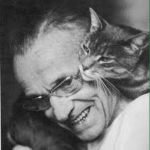Background
Molinier was born in Agen, France, on April 13, 1900. He was the son of a house painter and decorator.

Pierre Molinier with a cat.
Pierre Molinier with his works.
Pierre Molinier.
Pierre Molinier with a cat.
Pierre Molinier.






Molinier was born in Agen, France, on April 13, 1900. He was the son of a house painter and decorator.
At the age of 13, Pierre Molinier began his artistic practice as a landscape painter, working in the Fauve and Impressionist styles. He worked as a disciple painter to his father and in parallel took evening courses in drawing. Molinier was profoundly in love with his younger sister and deeply affected by her early death. When he was 18, Pierre Molinier took photographs of his dead sister. As an artist, he tried to resist his erotic phantasm and androgynous identity, which he unexpectedly discovered.
In 1919, Pierre Molinier settled in Bordeaux, working as a house painter until 1960. Being passionate about drawing and painting, Molinier practiced artistic painting in parallel. From the 1920s to the late 1940s, his painting was figurative and represented classic themes, including landscapes of Lot-et-Garonne, still lifes, portraits and also self-portraits. He first exhibited his paintings in 1927. Circa 1936 the artist experimented with abstract art.
Following the Second World War, he began to explore the esoterism and then fetishistic eroticism that characterized his later works. In 1955, he sent reproductions of his paintings and poems to the Surrealist André Breton. Breton initially encouraged Molinier’s work and assured Molinier of his support, he also proposed to organize exhibition in Paris, which took place from January 27 to February 17, 1956. Pierre Molinier presented 18 paintings at the Galerie À l'Étoile scellée, including Le Grand Combat, Succube, Comtesse Midralgar, Les dames voilées. However, the notoriously homophobic Breton later distanced himself from Pierre Molinier when he became aware of Molinier’s sexuality.
Starting from the 1960s, Molinier devoted himself totally to his photographic work. In 1965, the artist began to make autoerotic self-portraits and use photomontages in his Bordeaux apartment. He usually took pictures of himself and occasionally friends or other models, dressed in women’s lingerie and engaged in erotic and sadomasochistic acts. The artist chronicled the results of his exploration of subconscious transsexual desires in "Cent Photographies Erotiques". It graphically detailed images of pain and pleasure.
For the last 11 years of his life Pierre Molinier managed to play out his own most profound moments in the 'theatre' of Molinier's Bordeaux 'boudoir - atelier'. His photographs were intended to shock, bringing the feelings of either excitement or disgust. In the 1970s, his health began to decline, and he eventually committed suicide on March 3, 1976, at his home in Bordeaux, France.

Pierre Molinier was one of the most extravagant but beloved artist and photographer of the 20th century. He is now the subject of a number of monographs and exhibition catalogs. His works have inspired artists since the 1970s, including Andy Warhol, Robert Mapplethorpe, Vito Acconci, Cindy Sherman, etc.
Historians of today are recognizing him as one of the first performance artists. Molinier's works have been included in various exhibitions at the Los Angeles County Museum of Art, Centre Georges Pompidou (Paris), Tate Modern (London). At the 2013 Venice Biennale, the whole room was devoted to his works in the main exhibition.
Autoportrait au tabouret n°2 en tirage négatif
Autoportrait au fouet
Méditation vampirique
Portrait of Luciano Castelli
Portrait d'Hanel
L'étoile de six
Autoportrait au joug
L'odalisque turbulente
Collage
Effigy
The Model (Jean)
My Legs
Portrait of Luciano Castelli
Hanel 1, planche 30 du Chaman
Eperon d'amour
Untitled
Gog et Magog
Sur le pavois, planche 26 du Chaman
Autoportrait aux bas et au paravent
Senza titolo (autoritratto mascherato)
Poupée 2
Grande Mêlée
Fille Magique
A l'abri dans ma beauté
Ce qui est merveilleux
Hanel 2
Autoportrait au tabouret avec corset, jarretelles, masque, voilette et rose
Molinier was an atheist.
Pierre Molinier researched connections between religious ritual and sexuality. He believed they had been obscured by the post-Renaissance morality that he despised. He challenged the orthodoxies of art and morality, tried to destroy taboos.
Molinier was a homosexual and a transvestite. He lived the violence and sexual obsessions his fellow surrealists only dreamt about.
Molinier married Andrea Lafaye on July 7, 1931, in Bordeaux.
